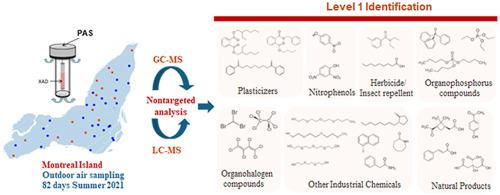通过被动采样城市空气的非目标筛选确定污染物的分布图。
IF 8.1
2区 环境科学与生态学
Q1 ENVIRONMENTAL SCIENCES
引用次数: 0
摘要
空气污染与肺癌发病率和死亡率的增加密切相关。由于许多半挥发性工业化学品、农药和燃烧副产品具有内分泌干扰或遗传毒性,它们在室外城市空气中的混合物,即使是微量的,也可能产生累积效应。然而,室外空气污染对人类健康影响的证据仍然有限,部分原因是其成分特征不明确。非靶向分析(NTA)基于液相(LC)和气相(GC)色谱分离和高分辨率质谱(MS)相结合,可以对环境样品中的污染物进行全面分析。在这里,我们提出了NTA方法的首次应用,通过分析2021年夏季在加拿大蒙特利尔岛部署的82天的40个被动采样器,使用LC-和GC-MS来表征室外城市空气中的化学混合物。已确认的25种分子特征包括硝基酚、杀虫剂/驱虫剂、增塑剂、有机磷化合物、有机卤素化合物、其他工业化学品和天然产物。首次在大气中检测到三甘醇单甲醚、三甘醇单丁醚、正辛基吡咯烷酮、喹啉n-氧化物、4-羟基苯乙酮、柠檬酸、2-苯乙酰胺和六氯乙烷。此前报道的大气颗粒物中,在室外大气气相中还检测到4-硝基苯酚、2,4-二硝基苯酚、三乙二醇和四乙二醇、壬酸、二甘醇二苯甲酸酯、己内酰胺、苯丙烯酸、蒎酸和氧化三苯基膦。住宅和公共区域之间的数据空间分组强调了人为活动对大气蒸汽成分的影响。这项研究有助于评估空气中化学混合物的暴露及其对人类健康的影响。本文章由计算机程序翻译,如有差异,请以英文原文为准。

Mapping the distribution of contaminants identified by non-targeted screening of passively sampled urban air
Air pollution is closely associated with increased lung cancer incidence and mortality. Because many semi-volatile industrial chemicals, pesticides and combustion by-products are endocrine-disrupting or genotoxic, their mixtures in outdoor urban air, even at trace levels, could have cumulative effects. However, evidence for the impact of outdoor air pollution on human health remains limited, partly because its composition is poorly characterized. Non-targeted analysis (NTA) based on the combination of liquid (LC) and gas (GC) chromatographic separation with high resolution mass spectrometry (MS), allows for the comprehensive analysis of contaminants in environmental samples. Here, we present the first application of an NTA approach using both LC- and GC-MS to characterize the chemical mixture in outdoor urban air by analyzing forty passive samplers deployed for 82 days during summer 2021 across the Island of Montreal, Canada. The confirmed 25 molecular features included nitrophenols, pesticides/repellents, plasticizers, organophosphorus compounds, organohalogen compounds, other industrial chemicals, and natural products. Triethylene glycol monomethyl ether, triethylene glycol monobutyl ether, n-octyl-pyrrolidone, quinoline n-oxide, 4-hydroxy-acetophenone, citric acid, 2-phenyl acetamide, and hexachloroethane were detected for the very first time in the atmosphere. Previously reported in atmospheric particles, 4-nitrophenol, 2,4-dinitrophenol, tri- and tetraethylene glycol, nonanoic acid, diethylene glycol dibenzoate, caprolactam, phenylacrylic acid, pinonic acid and triphenylphosphine oxide were also detected in the outdoor atmospheric gas phase. The spatial grouping of data between residential and public areas emphasizes the impact of anthropogenic activities on atmospheric vapor composition. This study facilitates the assessment of airborne exposure to chemical mixtures and its effects on human health.
求助全文
通过发布文献求助,成功后即可免费获取论文全文。
去求助
来源期刊

Chemosphere
环境科学-环境科学
CiteScore
15.80
自引率
8.00%
发文量
4975
审稿时长
3.4 months
期刊介绍:
Chemosphere, being an international multidisciplinary journal, is dedicated to publishing original communications and review articles on chemicals in the environment. The scope covers a wide range of topics, including the identification, quantification, behavior, fate, toxicology, treatment, and remediation of chemicals in the bio-, hydro-, litho-, and atmosphere, ensuring the broad dissemination of research in this field.
 求助内容:
求助内容: 应助结果提醒方式:
应助结果提醒方式:


